Sony Xperia Z3v Hands-On And Benchmarks
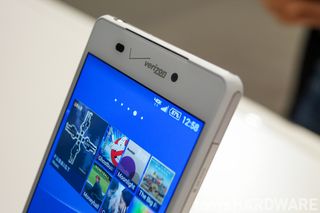
In New York City last Thursday, Sony Mobile held a launch event for its latest phone for the U.S. market, the Verizon-exclusive Xperia Z3v. This announcement is a rather big deal because although there have been a few exceptions (such as the Z1s on T-Mobile earlier this year), Sony’s phones haven’t really had a big carrier presence in the US, so releasing a flagship phone on America’s largest carrier is significant. In fact, the Snapdragon 801-powered Z3v is the first Sony phone available on Verizon since 2011’s ill-fated Xperia PLAY Android gaming phone (the one with a slide out gamepad).
Of course, while you’ve long been able to buy unlocked Xperia phones directly from Sony at full price, being able to buy the Z3v for a lot less on contract from a carrier significantly lowers the barrier to entry to owning one. While being available on Verizon will certainly increase Sony’s presence in the U.S., let’s hope that AT&T joins the party soon though, too. We’ve long been fans of the Xperia Z-series of phones, and it would be nice to see them available on even more U.S. carriers.
While the phone announced is called a Z three, at first glance it looks a lot more like a Z2 than the Z3 that was announced at IFA last month and is already on sale in Europe (and coming soon to T-Mobile in the U.S.). The Z3v is almost a hybrid of two phones, as its external design looks very similar to the Z2, while its internals (SoC and screen) and software are that of the new Z3. However, it is not 100% externally identical to the Z2 because the Z3v has improved dust resistance and also supports wireless Qi charging (a Verizon exclusive feature), but lacks the Z2’s aluminum chassis.
At the launch event we got a chance to spend a little time with the Z2v, and you can check out our hands-on video and some initial benchmarks below (with apologies for the focusing issues in the video).
Xperia Z3v specifications and comparison to the Z2/Z3
| Header Cell - Column 0 | Verizon Sony Xperia Z3v (D6708) | T-Mobile Sony Xperia Z3 (D6616) | Unlocked Sony Xperia Z2 (D6503) |
|---|---|---|---|
| SoC | Qualcomm Snapdragon 801 MSM8974AC | Qualcomm Snapdragon 801 MSM8974AC | Qualcomm Snapdragon 801 MSM8974AB |
| CPU Core | Krait 400 (4-core) @ 2.46 GHz | Krait 400 (4-core) @ 2.46 GHz | Krait 400 (4-core) @ 2.26 GHz |
| GPU Core | Adreno 330 @ 578 MHz | Adreno 330 @ 578 MHz | Adreno 330 @ 578 MHz |
| Memory | 3 GB RAM | 3 GB RAM | 3 GB RAM |
| Display | 5.2-inch TRILUMINOS IPS LCD Display @ 1920 x 1080 (424 ppi) with X-Reality Engine and Live Colour LED, Max brightness 400 nits (claimed) | 5.2-inch TRILUMINOS IPS LCD Display @ 1920 x 1080 (424 ppi) with X-Reality Engine and Live Colour LED, Max brightness 600 nits (claimed) | 5.2-inch TRILUMINOS IPS LCD Display @ 1920 x 1080 (424 ppi) with X-Reality Engine and Live Colour LED, Max brightness 400 nits (claimed) |
| Storage | 32 GB w/up to 128 GB microSD expansion | 32 GB w/up to 128 GB microSD expansion | 16 GB w/up to 128 GB microSD expansion |
| Battery | 3,200 mAh (non-removable) with wireless Qi charging. | 3,100 mAh (non-removable) | 3,200 mAh (non-removable) |
| Camera/s | Front: 2.2MP with 1080p videoRear: 20.7 MP Sony IMX XXX Exmor RS sensor with f/2.0 27 mm G Lens and LED flash. 4K video at 30 fps, 1080p video at 60 fps, HDR Video. ISO 6400 Max | Front: 2.2MP with 1080p videoRear: 20.7 MP Sony IMX XXX Exmor RS sensor with f/2.0 25 mm G Lens and LED flash. 4K video at 30 fps, 1080p video at 60 fps, HDR Video. ISO 12800 Max | Front: 2.2MP with 1080p videoRear: 20.7 MP Sony IMX XXX Exmor RS sensor with f/2.0 27 mm G Lens and LED flash. 4K video at 30 fps, 1080p video at 60 fps, HDR Video. ISO 6400 Max |
| Expansion Ports | microSD slot, USB 2.0 | microSD slot, USB 2.0 | microSD slot, USB 2.0 |
| Connectivity | Wi-Fi:Wi-Fi 802.11a/b/g/n/acCellular: CDMA, Cat 4 LTE bands 4, 13Other: Bluetooth 4.0, NFC | Wi-Fi:Wi-Fi 802.11a/b/g/n/acCellular: LTE bands 2, 4, 12Other: Bluetooth 4.0, NFC | Wi-Fi:Wi-Fi 802.11a/b/g/n/acCellular: Cat 4 LTE bands 1, 2, 3, 4, 5, 7, 8, 13, 17, 20Other: Bluetooth 4.0, NFC |
| Audio | Stereo front-facing speakers with DSEE HX Engine & High-Res audio | Stereo front-facing speakers with DSEE HX Engine & High-Res audio | Stereo front-facing speakers |
| Element Protection | IP65/IP68 rated - dust tight, water jet protected and waterproof | IP65/IP68 rated - dust tight, water jet protected and waterproof | IP55/IP58 rated - dust protected, water jet protected and waterproof |
| Color Options | Black, White | Black | Black, White, Purple |
| Dimensions | 5.85 x 2.89 x 0.35 in (148.5 x 73.4 x 8.9 mm) | 5.74 x 2.83 x 0.29 in (146 x 72 x 7.3 mm) | 5.78 x 2.88 x 0.32 in (146.8 x 73.3 x 8.2 mm) |
| Weight | 6.02 oz (170.7 g) | 5.36 oz (152 g) | 5.75 oz (163 g) |
| Operating System | Android 4.4.4 KitKat w/ Xperia UI | Android 4.4.4 KitKat w/ Xperia UI | Android 4.4.2 KitKat w/ Xperia UI |
| Price | $200 on a 2-year term, $TBA outright | $26.24 a month, $630 outright | $579 unlocked from Sony |
The mystery of the Z3v
When we were invited to last week’s event, we were expecting to learn more about the U.S. launch of Xperia Z3, which had already been announced to be coming to T-Mobile, but we were quite surprised by what we saw when we arrived. What we were being shown was a Verizon version of the Z3, but it didn’t look like the Z3 that had already been released in Europe. It looked like a Z2, a phone that we are quite familiar with, having used the Canadian model for an extended period.
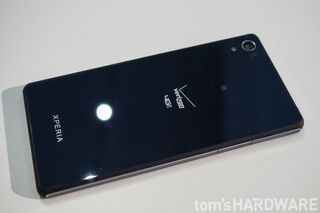
On further investigation though, there were a couple of differences between the Z3v and the Z2 that meant that the Verizon phone wasn’t simply a rebranded Z2 with slightly better internal hardware. For one, the aluminum frame of the Z2 has been replaced by a plastic one (we guess needed for the wireless charging), and the handset is also slightly larger than the Z2. During our research into this, we discovered that there is a China-only version of the Z2, with a model number of L50t, that DOES has a plastic frame, and after comparing images of the Z3v and this phone, it is clear that Sony has used it as the basis for this Verizon exclusive.
Design of the Z3v compared to the Z2 and Z3
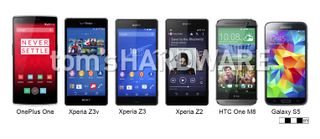
While we have yet to go hands-on with the Xperia Z3, from looking at the specification chart above and reading some other coverage from around the web, we can still compare the Z3v to its siblings. All three phones use Sony’s Omni-Balance design language, but only the Z3 has the latest iteration of it, with its rounded metal sides with nylon corners that both help with antenna attenuation issues and absorb impact if the Z3 falls and lands on its corner.
Stay on the Cutting Edge
Join the experts who read Tom's Hardware for the inside track on enthusiast PC tech news — and have for over 25 years. We'll send breaking news and in-depth reviews of CPUs, GPUs, AI, maker hardware and more straight to your inbox.
Both the Z3v and Z2 use the older, more squared-off design with rounded corners. The Z2's sides are still all metal, while the Z3v has a plastic ‘frame’ that has metal inserts. All three phones still have the attractive glass back and a design feature that looks great, but to be honest, it's not as practical, since it is more susceptible to being damaged that a plastic or metal back if the phone is dropped.
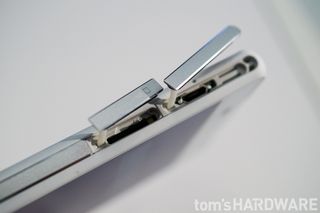
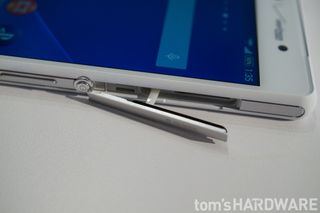
As for buttons and ports, all three Z-series phones feature the signature machined aluminum power button halfway down the right side with a smaller volume rocker below it. This rocker is a little too small and awkwardly placed to use comfortably on all three phones, but with their port layout, there isn’t really anywhere else it can go.
As is standard on all the Z-series phones we’ve looked at, the Z3v has a physical camera shutter button, which allows you to take pictures with the phone even when it is wet, which is a feature we wish more OEM’s would include on their phones.
The Z3v has the same microSD, SIM and USB ports as the Z2 and Z3, though the layout is slightly different. On the Z3v there are two doors on the right, a lower one for the microSD slot and a smaller upper on for USB. On the left side of the Z3v is the door covering the nano SIM slot. On the Z2 and Z3, there are only two covered ports – on the Z2 microSD on the right side, micro SIM and USB on the left. On the Z3, the microSD and nano SIM are on the right side, and the USB port is on the left.
All three Xperia phones are waterproof, but both the Z3v and Z3 has improved dust-resistance. The Z2 is IP55/58 rated and both Z3’s are IP65/68 rated. This means that all three phones can be continuously submerged in up to 3 meters of water. The first number of the rating refers to the dust resistance rating, and the ‘6’ rating of the Z3v and Z3 mean that they are dust-tight, instead of just dust-proof. This has probably been achieved by redesigning the seals on the port cover doors.
CORRECTION: Sony clarified to us that the manufacturer declares a device's depth rating and the submersion duration for IPX8 compliance. So in the case of the Z3v, it "can be kept under 1.50 metres of freshwater for up to 30 minutes."
As for dimensions, all three Xperias are of a similar size and are certainly big phones. While the Z3 is a step in the right direction, being slightly smaller and lighter than its predecessor, the Verizon spin-off, being based on the larger Chinese L50t variant, is bigger. Thankfully the size difference is an almost unnoticeable, being measured only in millimeters or fractions of an inch. However, the Z3v is quite a bit heavier than its brethren.
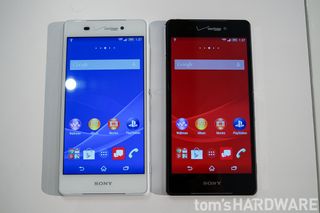
As for colors, the Xperia Z3v will be available in black and white, and the T-Mobile Z2 will be available only in black (in other markets the Z3 is available in other colors). The unlocked Z2 is available in black, white and a striking purple.
Screen
The Z3v has a 5.2-inch 1080p IPS display with excellent viewing angles that are vastly improved over those of the last carrier-sold Z-series phone, the Z1s. Like the Z2 and Z3, it uses Sony’s TRILUMINOS screen technology that allows for a wider color gamut that most IPS LCD screens found in cellphones, approaching that of AMOLED displays. It also uses (again, as do the Z2 and Z3) Sony’s Live Color LED technology which is supposed to help produce brighter richer colors, without being oversaturated.
At the event we were told that the Z3v’s screen was a lot brighter than the Z2’s, and while it did look plenty bright at the launch, we had no way of measuring its actual output. The claimed maximum brightness of the Z3v’s screen is 600 nits, which is the same as the Z3’s and quite a bit more than the 400 nits of the Z2. When we tested the Z2, its screen's biggest weakness was its brightness, so we are glad to see that Sony has addressed this.
UPDATE: Sony got back to us after the event to clarify that, in fact, the Z3v does still use the same screen as the Z2, not the brighter one of the Z3.
Camera
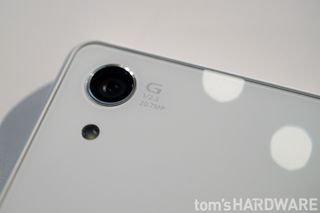
The Xperia-Z series of phones have been able to lay claim to having the highest resolution cameras of any Android smartphone since last year’s launch of the Z1. The 20.7 MP Exmor RS sensor found in the Z1 carried over to the Z2, and it now carries over to the Z3v and Z3. While this sensor was exclusively only available on Sony’s phones, it does look like Sony is now opening up sales of it to other OEMs, since the recently announced Meizu MX-4 seems to be using it.
Of course, megapixels aren’t everything; the size of the sensor is also important, and the one found in the Z3v (and Z1/2/3) is 1/2.3", which is quite large for a phone sensor. However, because it also has such as high MP count, the actual pixel size isn’t going to be as large as that of some competing phones, which will impact low-light performance. On the Z3v, (and it predecessors) Sony has paired this very high-resolution sensor with Sony’s G Lens optics, which helps improve image quality.
The Xperia Z3 does have a few improvements to the camera hardware that the Z3v, unfortunately, does NOT have. The Z3’s G Lens, while still f/2.0 is slightly wider at 25 mm (vs. 27 mm for the Z2 and Z3v). It is also capable of shooting at up to ISO 12800 while the maximum ISO for the Z3v and Z2 is 6400 in Superior auto mode. We’re not sure if this change is sensitivity is due to the Z3 using an upgraded sensor, or if it is just a software change, but it is disappointing that Sony didn’t include these camera upgrades in the Z3v.
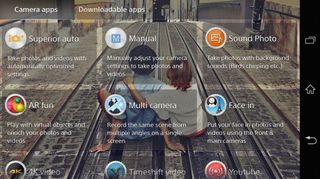
On the camera software side, the Z3v does include the new shooting modes that have been included with the Z3. The first is ‘Multi camera’, which lets you connect multiple Z3v’s (or other compatible Sony cameras) through Wi-Fi direct to shoot the same image from multiple angles. The second, ‘Face in’, is a picture-in-picture mode that allows you shoot an image using the front and rear camera simultaneously, and the last is ‘Sound Photo’ that records and audio clip with your picture.
As for imaging performance, we didn’t have time to test out the Z3v’s capabilities, and we haven’t used the Z3 yet. We have, though, used the Z2’s camera quite a lot, and our results from it have been mixed. While it is capable of shooting some impressive pictures, you need to use manual mode more often than not to achieve the best results, since we found that the automatic ‘Superior auto’ mode often chose the wrong settings, especially in low-light and challenging lighting conditions. Of course, Sony may have addressed these problems on the Z3v and Z3.
Hardware specs, audio upgrades and wireless charging

The Xperia Z3v's internal hardware is comparable to that of nearly all today’s current Android flagships. It uses a Snapdragon 801 SoC, like its predecessor, but it has the faster 2.46 GHz MSM8974AC variant, the same as the Z3. It has 3 GB of RAM, like the Z2 and Z3, but it does have 32 GB of internal storage, which is an upgrade from the Z2's and international Z3's 16 GB. (The T-Mobile Z3 will also have 32 GB). This internal storage can be expanded using the microSD slot with an extra 128 GB of space.

The Z3v also has the same 3,200 mAh battery found in the Z2, not the smaller 3,100 mAh found in the Z3 (which was probably chosen to shave off a little weight and thickness from the newer model). The big new and exclusive hardware feature of the Z3v is its wireless charging capabilities. It supports the more widely adopted Qi wireless charging standard, which is also used by phones from LG, Nokia, Motorola and Samsung. At the event, Sony showed the Z3v charging on a regular wired charging pad and from the $60 CPW5 Wireless Portable Power Supply (pictured above).
On the Audio side, the Z3v has the same front-facing stereo speakers as the Z2, but internally the same upgraded software features of the Z3 which allow you to listen to High-Res audio tracks. The Z3v also has Sony’s DSEE HX (Digital Sound Enhancement Engine) technology that up-scales low-bitrate audio files to High-Res quality. While this feature sounds great on paper, we’d have to test it fully to see if it lives up to its claim of improving the audio quality of your MP3s.
Performance
| Header Cell - Column 0 | Xperia Z3v | Xperia Z2 | LG G3 | Nexus 5 | iPhone 6 |
|---|---|---|---|---|---|
| Geekbench 3 Pro Single-Core Score | 973 | 930 | 1010 | 916 | 1631 |
| Geekbench 3 Pro Multi-Core Score | 2699 | 2759 | 2660 | 2803 | 2921 |
| Basemark OS II Full Overall Score | 1157 | 1195 | 1068 | 1173 | 1284 |
| Basemark X 1.1 Full Medium Score | 24341 | 24702 | 24351 | 21035 | 31433 |
| Basemark X 1.1 Full Medium Off-screen Dunes/Hangar fps | 26.61/35.5 fps | 27.37/35.76 fps | 27.20/35.09 fps | 22.62/30.96 fps | 28.45/50.19 fps |
Unfortunately, at the Z3v launch event we only had a limited amount of hands-on time with a demo unit, so were not able to run our complete suite of benchmark tests. We managed to gather some CPU and overall system performance results using Geekbench 3 Pro and Basemark OS II, as well as some GPU performance results using Basemark X 1.1.
As you can see from the chart above, the 2.46 GHz Snapdragon 801-powered Z3v performs as expected at around the same level as all its other 801-powered peers. Any variance you see in the results of the 801-powered phones above (even the 'slower' 2.26 GHz 801AB-powered Z2) is more down to testing variance and software builds rather than any real-world performance difference.
It is interesting to see that the 801-powered devices don’t score much higher than the 800-powered Nexus 5, but this is due to the fact that the Krait CPU in the 800 and 801 SoC is basically the same. When you compare the Z3v and the other Android phones to the A8-powered iPhone 6, it is clear though that Apple’s latest and greatest has the clear performance edge, on both the CPU and GPU front.
While we weren’t able to run any battery tests in the short time we had, we have been able to test the Xperia Z2, which uses the same 3,200 mAh battery. Using the BatteryXPRT test, we recorded 15.5 hours of use from the phone in the test ‘Network’ mode, and we expect a similar result from the Z3v.
Software and PS4 Remote Play
The Xperia Z3v runs Sony’s latest Xperia UI over Android 4.4.4. This is the same UI as the Xperia Z3, and it features larger icons, similar to those of the Nexus 5 and other phones running the Google Now launcher. Sony’s UI has always been one of the more attractive OEM skins, and nothing has changed here. However, Sony is little further away from incorporating Android L's Material design language in its Xperia UI due to its reliance on a lot of skeuomorphic design elements, which does make it feel a little dated when compared to Sense 6 and the latest LG skin.
As for preinstalled software, being a Sony phone, it comes with a full suite of Sony apps for you to download content from Sony’s media ecosystem. Also being a Verizon phone, the Z3v comes with a full suite of Verizon bloatware (carrier apps) that are going to be a pain to remove. But that’s the price you pay, we guess, for buying a phone from a carrier in the U.S. We still like to think that buying a carrier-free unlocked phone is always the best (but of course not always the cheapest) way to go.

The last major software feature we were shown at the event was PS4 Remote Play. This feature allows you to stream games from your PS4 to the Xperia Z3v (and Z3), similar to the game streaming feature of the Nvidia Shield. Remote Play is already available for the PlayStation Vita and TV and requires you to be on the same network as your PS4 and works over Wi-Fi.
While we weren’t able to get a real feel for how well it worked in the limited time we had at the event, if you're a PS4 owner, Remote Play is certainly a compelling reason to make your next phone an Xperia Z3 or Z3v, as this feature will be exclusive to Sony’s phones. Sony was also showing the $40 GCM10 Game Control Mount (shown above) that allows you to attach a Dualshock 4 controller to the Z3v. PS4 Remote Play will not be available when the Z3v launches on October 23rd, but will be soon after in November.
Conclusion
We came away pretty impressed with the Xperia Z3v in the short time we spent with it, and having a flagship Xperia phone available on the U.S’s largest carrier should get more Sony phones into people’s hands. It is a pity that Sony couldn’t incorporate some of the Z3’s design changes and improved camera hardware into the Z3v, but its Qi wireless charging somewhat makes up for these omissions.
The Sony Xperia Z3v will be available from Verizon on October 23 for $200 on a 2-year term, and for more information and to pre-register to buy one, you can check out Sony’s site.
Follow Alex Davies @alexbdavies. Follow us @tomshardware, on Facebook and on Google+.
Most Popular





